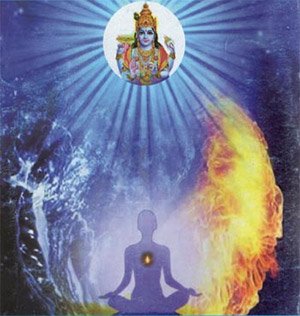Siddhanta Sangraha of Sri Sailacharya
by E. Sowmya Narayanan | 2008 | 30,562 words
Siddhanta Sangraha Chapter 8 (English translation), entitled “the theory that gold, gem, etc., belongs to earth” as included in the critical edition and study. The Siddhanta Samgraha is a Sanskrit philosophical text dealing with Vishishtadvaita in five hundred Sanskrit verses. It was written by Shri Shailacarya (18th century) and closely follows the philosophy of Vedanta Deshika (13th century).
Chapter 8 - The theory that gold, gem, etc., belongs to earth
73. The gold is the substance of earth (pārthivadravya) and is not the substance of fire (tejo dravya). The substance fire is two fold namely, prabhā (brilliance) prabhāvān (one who possesses that brilliance).
74. The statement that “the brilliance (prabhā) is the (avayava) particle of the lamp” is not correct. The gem is the substance of the earth and its brilliance is the substance of tejas (fire).
75. Similarly through the inferential knowledge we prove that the lamp (dīpa) and its brilliance (prabhā) is not the substance of earth. The red colour belongs to the fire substance (tejas) and it has been accepted as the extraordinary (asādhāraṇa) cause.
76. Through the scriptural statement which says that the red colour exists in fire. The water (āpas) has four qualities namely, śabda, sparśa, rūpa (form), rasa (taste).
77. According to scriptures the white colour (śukla rūpa) for water is natural. The qualities such as śabda, sparśa, rūpa, rasa and gandha are belonging to the earth (pṛthvī).
78. The scriptures reveal that the earth has black colour innately. Actually tamas is the substance of the earth because it has the black colour.
79. According to the statement (darkness is the absence of light) some people say that it is not the substance of earth. But it is not true. Also the statement “nīlam tamaḥ calati (black darkness moves)” proves that tamas is the substance of earth, as it has the quality (guṇa) and the action (kriyāvān)[1]. There cannot be a category called non-existence (abhāva) different from the existence (bhāva). Non-existence is the quality of bhāva itself and it is not the contrary to drāvyatva or substanceness.
80. The statement that ‘the tamas is an unmanifested element’ is being said as it covers the knowledge and not because it is not observed.[2] Here, it has been decided that the occurrence of the word tamas should be proved by the learned (prājñās) like the word mṛtyu, which denotes yama.
Footnotes and references:
[1]:
The naiyāyikas does not accept the tamas as a separate category while the mīmāṃsakas admit tamas as a separate category. In this regard Viśiṣṭādvaitins admit tamas as a category on the basis of scriptural authority.—Nyāya Siddhāñjana. p. 68.
[2]:
Viśiṣṭādvaitins do not accept the non-existence (abhāva) as a separate category, for them a substance should exist in some form or the other. See Nyāya Siddhāñjana. pp. 68-72.
Conclusion:
 This concludes The theory that gold, gem, etc., belongs to earth according to Vishishtadvaita philosophy explained by Shri Shailacarya. This book follows the model of Vedanta Deshika although the Vishishta Advaita school was originally expounded by Shri Ramanuja. Vishishta-Advaita is one of the various sub-schools of Vedanta which itself represents one of the six orthodox schools of Hindu Philosophy. They highlight the importance of the Upanishads, the Bhagavad Gita and the Brahma Sutras.
This concludes The theory that gold, gem, etc., belongs to earth according to Vishishtadvaita philosophy explained by Shri Shailacarya. This book follows the model of Vedanta Deshika although the Vishishta Advaita school was originally expounded by Shri Ramanuja. Vishishta-Advaita is one of the various sub-schools of Vedanta which itself represents one of the six orthodox schools of Hindu Philosophy. They highlight the importance of the Upanishads, the Bhagavad Gita and the Brahma Sutras.
